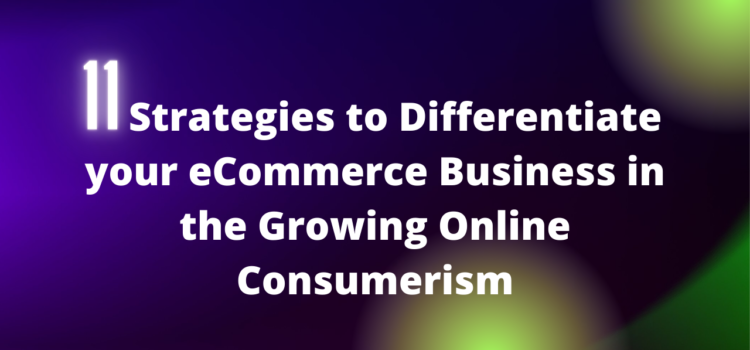Online consumerism is on the rise worldwide. Recent stats of Statista suggest, there are over 2.14 billion digital buyers expected to shop online in 2021. The spike in online shopping behavior continues to grow even further, and so does the eCommerce industry around the globe.

Positioning your eCommerce business as a trusted brand is thus more important to gain reputation, and to acquire a sound customer base in the cut-throat competition. Serving customers well virtually requires eCommerce business owners to understand its customer pool and to bring something unique to the customers’ palate.
Stick with us while we take you through some actionable tactics to do eCommerce business branding.
It all begins with a diligent customer and market analysis, employing an eCommerce web design company to design an eCommerce website that end-users like to interact with, and key branding strategies to better position your online business.
Table of contents
Determine Your Audience Pool
The first and foremost essential step is to define who you want to sell your products or services to. Having a clear strategy of who you want to go after is the curse of establishing a successful eCommerce business. Is there enough demand for products that you want to sell online? Do you intend to sell local or globally are certain questions that should be answered upfront before establishing an eCommerce business?
Determination of the target audience helps eCommerce business owners in many ways, such as:
- Creating more targeted campaigns for ramping up conversions by creating customized and relatable content.
- Give each customer a personalized experience.
- Easily do client segmentation
- Converge your customized campaign strategy.
- Decrease marketing costs
Know Your Rivals
Doing competitors analysis is another foundational step for almost every online business and brand. Before establishing your brand, you have to figure out whether you have competitors selling services or products similar to your brand. What branding strategies do your competitors utilize and how you are going to differentiate your brand from others.
You can employ various competitor analysis techniques and tools. Many established business employee SWOT(Strength, Weaknesses, Opportunities, and Threats) analysis. SWOT analysis enables businesses to identify competitive edges, areas where a brand needs further improvements, opportunities for expansion, and possible threats in the long and short term.
However, when it comes to establishing an online business, you cannot afford to ignore tools that every eCommerce SEO Services Company utilizes as a part of the branding and marketing strategy.
Here are some most frequently used tools for competitor analysis.
- Quick Search
- MozBar
- SpyFu
- Ahrefs
- SimilarWeb
- Feedly
- BuzzSumo
- SEMrush
- Google Keyword Planner
- WooRank
- Owletter
- Majestic
Certainly, it won’t be feasible to use every one of these tools all at once. However, it’s a good practice to use a mix of these tools that can get you in-depth competitor analysis, backlinks audit, and the marketing strategy of your competitors.
Showcase Your Unique Selling Propositions
Your online business cannot be distinct enough, given today’s competitive market. However, still, there are ways you can differentiate your business from others. When it comes to eCommerce, you have got to capitalize on all the tricks and marketing gimmicks that entice the end-users to come by and stick to purchasing your products or services.
Your business unique selling propositions (USPs) are what make you apart from your rivals. The more you have them, the better off your eCommerce business will be.
Be Customer-Centric
If you want customer retention, exercise being highly customer-centric. As the saying goes, “a dead fish spoils the entire pool”. When it comes to serving people online, you need to make sure every customer is happy with doing business with you. In an eCommerce business, one unhappy customer can have worse ramifications on your business reputation. A tiny negative review can lead to shying away from a good chunk of new customers.
A lot of times, a little out-of-the-box thinking can come very handy for positioning your brand identity in your customer’s mind. This may include certain marketing gimmicks such as offering discounts on products on special days and festivities. Perhaps, a free home delivery service can be a box full of cherries for certain customers.
Simply put, being customer-centric will yield more brand identity and trustworthiness. As an eCommerce brand, you have to earn the trust of your customers to thrive in the growing online consumerism.
Create a Robust Content Strategy
Make your brand’s voice heard with engaging content. When it comes to content marketing, consistency is key to success. Your sales pitch, brand awareness or a piece of contextual content must be persuasive and actionable.
A well-thought-out content plan helps in grabbing people’s attention, luring in customers, and provoking them to make a purchase decision.
Several reports indicate that more than 90% of companies today rely heavily on content marketing. Unlike other traditional marketing practices, content marketing saves firms around 60% budget and generates leads 3 times more than conventional marketing.
Furthermore, leverage heavily the social media platforms. Engage your audience in content that could trigger virility, impressions boost and clicks.
Tell Your Brand’s Story
Make your brand’s voice heard loud and clear. What does your brand stand for? Come up with a narrative of your brand. Stories captivate the user’s attention.
Associate your brand with something that people care about. Many brands today employees various types of corporate social responsibilities activities to give back to the community. Such affiliations help brands create widespread consumer loyalty as well as brand awareness.
Place a Premium on Email Marketing
As per Statista, there are over 3.9 billion email users worldwide in 2019. The figure is expected to grow to 4.3 billion by 2023. It specifies that email marketing is used by one out of every two people around the world.
Consequently, email marketing can be extremely valuable to your eCommerce business identity. Collecting data from the customers such as birthdays and wishing them on their days can help rejuvenate your brand loyalty and identity, and make your customers a sense of belongingness.
Website Design and Navigation
Since you are severing your customer online, maybe in other countries as well. Thus your eCommerce website design has to be extremely user-friendly. The moment when someone lands on your website creates the first impression. Make sure your brand site has all such attributes and aesthetics that tick in visitors’ minds.
Easier navigation helps in delivering a great user experience and customers linger till the end. Also, make sure that you have an easier checkout process in place so that no customer gets confused in making the transaction to your brand.
Website Loading Speed
No doubt, website loading speed is a major ranking factor for just about any search engine. So is highly important for the end-users.
As an eCommerce brand, you cannot afford to have a site that takes a long to load up. A slower website leads to high bounce rates and alienates visitors from coming on to your brand’s website.
Products Positioning and Listing
If your brand is selling physical commodities, make sure they are positioned within proper categories. In addition, provide customers with reviewing options on each product in the catalog. It helps visitors to easily find what they are looking for and products with most reviews pop up automatically to the sticky/featured section of the eCommerce website.
Have a Clear Exchange & Return Policy
Your brand must have a well-thought-out return or exchange policy. It does help your brand stand apart from those who, otherwise don’t have any return or exchange policy. Customers often need to replace return products for a variety of reasons, and thus having clear terms conditions on return can help create brand trustworthiness.
Wrapping Up
Online consumerism is an all-time rising phenomenon. Over 65% of people today shop online and the spike of online shopping is expected to grow even further.
As an eCommerce business, it is essential to pay careful attention to marketing and branding. With tools and strategies that are laid above can help create a long-lasting brand identity for your e-commerce business.
It all begins with customers and ends with customers. Successful brands heavily invest in ways how to position themselves as trustworthy in the eyes of end-users. Thus, a proper analysis of the target audience, target market, competitors is the corn-stone of every branding strategy.
In addition, giving ample attention to aesthetics such as brand name, logo, tag line, and web designing outlook. These elements create the first and last impression on the end-users.
Invest into a compelling brand narrative and don’t shy away to share your brand story, and what your brand stands for with the audience.
[yasr_visitor_votes]

